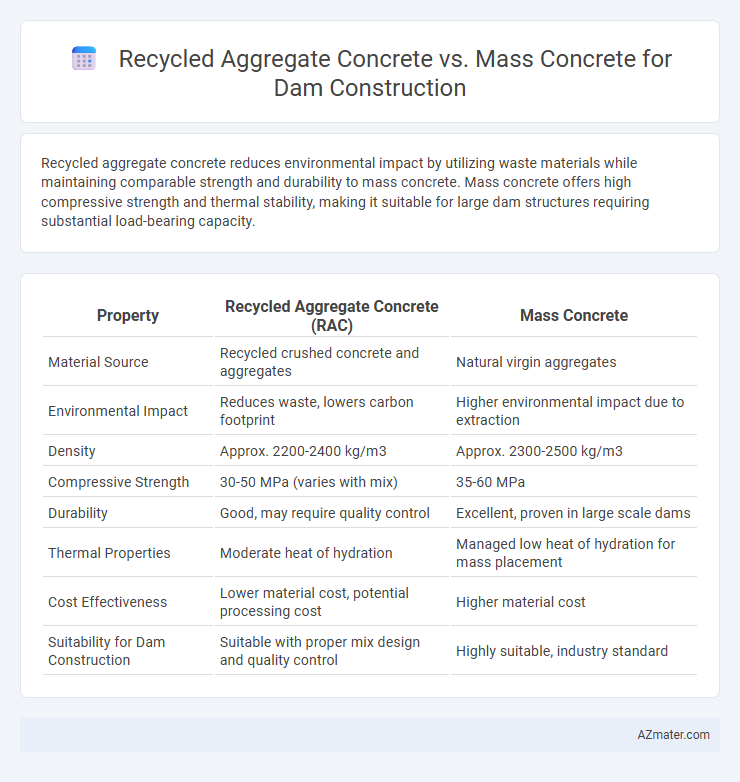Recycled aggregate concrete reduces environmental impact by utilizing waste materials while maintaining comparable strength and durability to mass concrete. Mass concrete offers high compressive strength and thermal stability, making it suitable for large dam structures requiring substantial load-bearing capacity.
Table of Comparison
| Property | Recycled Aggregate Concrete (RAC) | Mass Concrete |
|---|---|---|
| Material Source | Recycled crushed concrete and aggregates | Natural virgin aggregates |
| Environmental Impact | Reduces waste, lowers carbon footprint | Higher environmental impact due to extraction |
| Density | Approx. 2200-2400 kg/m3 | Approx. 2300-2500 kg/m3 |
| Compressive Strength | 30-50 MPa (varies with mix) | 35-60 MPa |
| Durability | Good, may require quality control | Excellent, proven in large scale dams |
| Thermal Properties | Moderate heat of hydration | Managed low heat of hydration for mass placement |
| Cost Effectiveness | Lower material cost, potential processing cost | Higher material cost |
| Suitability for Dam Construction | Suitable with proper mix design and quality control | Highly suitable, industry standard |
Introduction to Dam Construction Materials
Recycled aggregate concrete (RAC) incorporates crushed concrete debris as a partial substitute for natural aggregates, offering sustainable solutions by reducing landfill waste and conserving natural resources in dam construction. Mass concrete, traditionally used in dam construction, requires careful thermal control and low permeability to withstand high structural loads and environmental stresses. Selecting materials for dam construction involves evaluating durability, strength, thermal properties, and environmental impact to ensure long-term performance and safety.
Defining Recycled Aggregate Concrete
Recycled aggregate concrete (RAC) utilizes crushed concrete waste as aggregate, offering an eco-friendly alternative to traditional mass concrete in dam construction. This sustainable material reduces natural resource consumption and landfill waste while maintaining structural integrity and durability crucial for dam stability. Compared to conventional mass concrete, RAC demands careful mix design to optimize performance and mitigate potential durability challenges inherent in recycled aggregates.
Overview of Mass Concrete in Dams
Mass concrete in dam construction refers to the large volume concrete placement used to form gravity or buttress dams, emphasizing durability and minimal thermal cracking. It requires careful thermal control during curing because the hydration of cement generates significant heat, causing internal temperature gradients that can lead to structural weaknesses. This type of concrete typically uses conventional aggregates, and its density and strength are optimized to withstand high hydrostatic pressures and environmental exposure over long service lives.
Material Properties: Strength, Durability, and Workability
Recycled aggregate concrete exhibits slightly lower compressive strength compared to mass concrete but offers enhanced sustainability by utilizing construction waste. Durability in recycled aggregate concrete can be improved through proper mix design and treatment of recycled aggregates, ensuring resistance to freeze-thaw cycles and chemical attacks common in dam environments. Workability may be reduced due to the angularity and porosity of recycled aggregates, requiring adjustments in water content and admixture use to achieve desired consistency and ease of placement.
Environmental Impact and Sustainability
Recycled aggregate concrete significantly reduces environmental impact by minimizing landfill waste and lowering the demand for natural aggregates, conserving natural resources in dam construction. Its use decreases carbon emissions associated with quarrying and transportation compared to mass concrete, enhancing sustainability. Mass concrete, while traditionally durable, involves higher energy consumption and resource depletion, making recycled aggregate concrete the more eco-friendly choice for sustainable dam projects.
Cost Comparison and Economic Viability
Recycled aggregate concrete offers significant cost savings in dam construction due to reduced raw material expenses and lower transportation costs compared to mass concrete, which relies heavily on virgin aggregates and cement. The economic viability of recycled aggregate concrete improves with large-scale applications and local availability of recyclable materials, making it a sustainable alternative that reduces waste disposal costs. Mass concrete remains costlier due to higher cement content and energy-intensive production, but it provides superior durability and strength in critical dam sections, requiring a careful balance between upfront costs and long-term performance.
Performance in Harsh and Large-Scale Conditions
Recycled aggregate concrete (RAC) demonstrates enhanced sustainability and comparable compressive strength to traditional mass concrete, making it suitable for dam construction in harsh environments. RAC exhibits improved resistance to freeze-thaw cycles and chemical attacks due to the inherent properties of recycled aggregates, ensuring durability under aggressive conditions. In large-scale applications, the optimized mix design and reduced environmental impact position RAC as a viable alternative to conventional mass concrete without compromising structural performance.
Case Studies: Practical Applications in Dams
Case studies on dam construction highlight recycled aggregate concrete (RAC) as a sustainable alternative to traditional mass concrete, demonstrating comparable strength and durability in projects like the Toysi Dam in Finland. Research from the Xi'an Dam project in China reveals RAC's enhanced resistance to thermal cracking, reducing maintenance costs over time. These practical applications underscore the viability of RAC in large-scale infrastructure, balancing environmental benefits with structural performance requirements.
Long-Term Maintenance and Lifecycle Analysis
Recycled aggregate concrete (RAC) for dam construction offers enhanced sustainability by reducing environmental impact and lowering material costs, yet it may require more frequent long-term maintenance due to potential variability in durability and permeability compared to mass concrete. Mass concrete demonstrates established performance with proven durability and lower maintenance demands over a dam's lifecycle, supported by extensive real-world data and standardized mix designs that enhance structural reliability. Lifecycle analysis indicates RAC can reduce carbon footprint and initial costs but necessitates comprehensive durability assessments to ensure long-term structural integrity and cost-effective maintenance schedules.
Conclusion: Choosing the Optimal Material for Dam Projects
Recycled aggregate concrete offers environmental benefits and cost savings by reusing construction waste, while mass concrete provides superior durability and structural integrity essential for large-scale dam construction. Selecting the optimal material depends on project-specific requirements such as load-bearing capacity, durability, and sustainability goals. Integrating recycled aggregates in mass concrete can enhance eco-friendliness without compromising performance in dam construction.

Infographic: Recycled aggregate concrete vs Mass concrete for Dam construction
 azmater.com
azmater.com